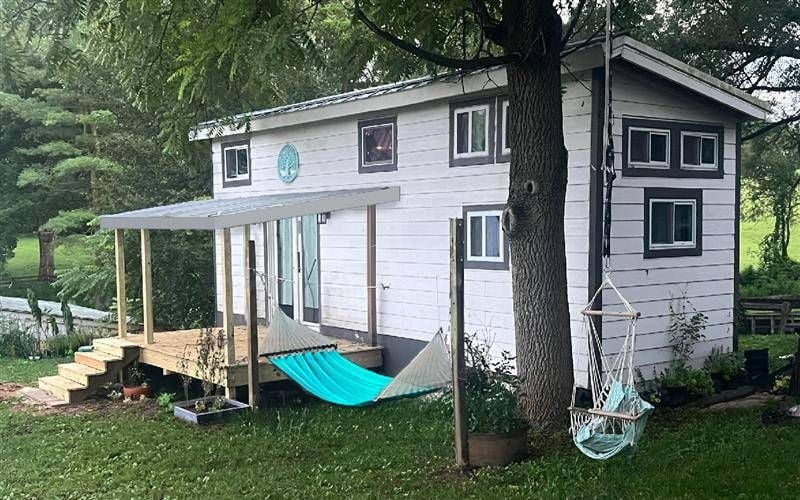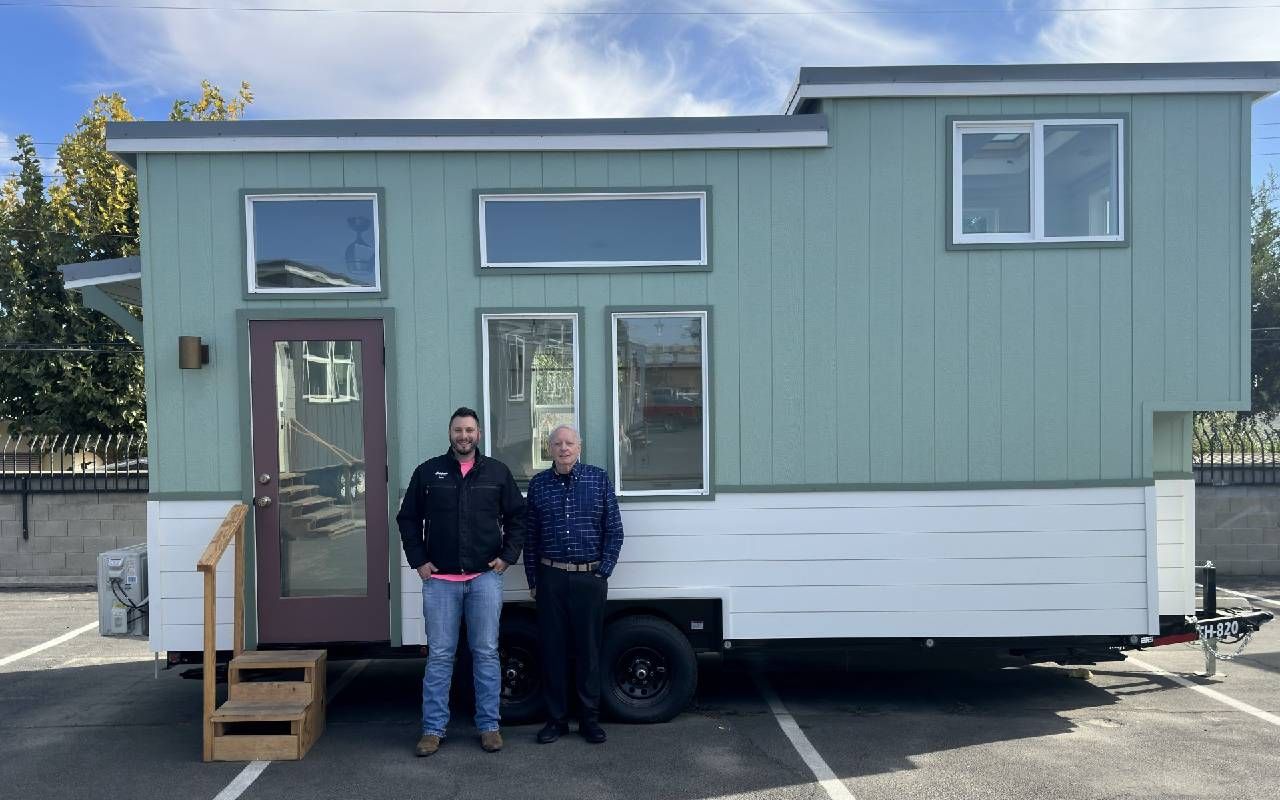Getting Smaller in Retirement
No, not your body, your next home — if you can radically downsize
Editor’s note: This is the first Next Avenue article on moving to “tiny homes” in retirement — or earlier. The second article, Radical Downsizing, is scheduled to be published in January 2024.
Remember that Steve Martin routine "let's get small"? A new generation of homebuilders have taken that literally to heart in the tiny home movement, which is attracting growing attention from retirees looking to radically downsize.

While there's no official definition of a tiny house, the phrase generally refers to structures that are less than 1,000 square feet and offer extremely efficient use of space and energy. While they can be equipped with wheels and built in a factory using modular design, tiny houses should not be mistaken for mobile homes or trailers.
Indeed, tiny houses, which can be sited nearly anywhere that permits them, require modest utility connections and consume a fraction of the energy and resources of conventional homes. These dwellings are a low-cost opportunity for retirees to downsize and live flexible, more affordable lifestyles nearly anywhere.
Tiny Communities to Match
The biggest bonus is that downsizing into a tiny home can help many people become mortgage free, making more of their disposable income available for travel.
Jill Kanto, a web developer, and owner of Choose Tiny, moved into a 300-square-foot, custom-designed house that she built seven years ago. Her home features two lofts, can sleep five (with a king-sized and twin beds) and is situated in a tiny-home community in rural Baltimore County, Maryland.
"I downloaded blueprints, hired a carpenter and found a tiny home community within a farm."
Her water comes from a local spring and electricity comes from a community hook-up. Propane fuels her water heater. An electric heat pump warms and cools her home.
"I downloaded blueprints, hired a carpenter and found a tiny home community within a farm," says Kanto, who volunteers to promote the tiny home movement and "feels a sense of peace" in her dwelling, which costs about $50 a month for electricity.
Her biggest expense is $120 a month for satellite internet, which she needs for her at-home job. She sees her tiny lifestyle as a potential route to an affordable retirement.
For many, letting go of the bulk of their material possessions can be a daunting challenge. But for those who no longer need a large living space and attendant expenses, a tiny house "can be a great path to retirement — or you can do it for financial or environmental reasons," Kanto says.
Parting with Your Possessions
"If someone is struggling with letting go of enough of their possessions," Kanto adds, "they could consult with people who specialize in downsizing and/or move into a community that has amenities that replace their need for some of their possessions, such as a wood shop, tool library or shared office space.
"For some people, 400 square feet and under is too small," she adds. "Small houses — roughly 400 to 1,000 square feet — can be a great entry point for people to harness some of the same benefits as a tiny house."
Since most tiny homes are not on permanent foundations, local building and zoning codes dictating size restrictions often don't apply. Municipalities often dictate a minimum square footage for permanent homes.
Tiny homes can be DIY customized, stick built and assembled for less than 20% of comparable structures. A typical tiny home constructed by a local builder can range from $55,000 to $85,000, although you can spend more if you decide to customize.
A Rural Phenomenon, for Now
Typically, tiny homes and communities that support them are not found in big cities or suburbs. They are generally in rural areas with minimal building and zoning codes, according to Dan Fitzpatrick, president of the California-based Tiny Home Industry Association.
"Often they may site a tiny home on their lot for a caregiver. Some may even rent them out to supplement their retirement benefits."
"What holds back tiny home acceptance is zoning codes," says Fitzpatrick. "That's why you're seeing them pop up all over the place in areas of rural Texas, for example." Many Texas municipalities have no zoning ordinances.
If you care about the environment, tiny homes have a meager carbon footprint, using less than 10% of the energy a conventional home would consume. Since you have less space to heat and cool in a tighter thermal envelope, energy costs are minimal.
Most new tiny-home buyers are millennials, Fitzpatrick says; among those aged 55 and over, there are more single women than men. "They are downsizing," he says. "Often they may site a tiny home on their lot for a caregiver. Some may even rent them out to supplement their retirement benefits."
Legal Definition of Tiny Homes
Unless you find a tiny-home-specific community to park your house, you will need to find a suitable site with electricity, water and sanitary disposal.
Where you park your tiny home is a matter of how local government classifies such structures, which requires some homework. Some jurisdictions classify them as mobile homes, while others consider them trailers or recreational vehicles. Some places are flexible, while others are strict.
Some communities regard tiny homes as "Accessory Dwelling Units" that you can situate in the yard of an existing home as long as you obtain the necessary permits from local building and zoning authorities.
Making Tiny Decisions
The essential first step in deciding whether a tiny home is right for you is to decide whether you want to live in an unconventional, compressed space. Keep in mind that tiny houses are the polar opposite of McMansions. They won't have "great" rooms or specialized spaces like recreation rooms.
They are not designed to shelter a lot of people and have limited storage space. What you gain in compact, efficient and energy-saving design, you lose in overall square footage.
"In recent years, countries in North America have witnessed a steady increase in the construction of tiny houses."
Fitzpatrick, who is also a tiny home builder, finds that many new tiny-home communities are in low-density, minimally regulated locales.
Tiny House on the Prairie
Do you have a pioneer spirit? You can also "homestead" your tiny home — that is, buy land and build on it. Again, you would have to ask local county building authorities if the structure you're planning would be legal. And you will still need water and electricity, unless you can sink your own well and go "off grid" with solar power, batteries and propane.
Once you sense that you want to try tiny-house living — and you know where you may want to relocate — you can either buy or build your structure. Wal Mart sells tiny-house blueprints and there are dozens of vendors online.
Before you build, you can rent a home to see if it's a good fit. There are an astounding variety of home designs that you can survey online. They range from traditional cottages to two-story ultra-modern, energy-efficient units.
Sales Grow, Houses Don't

If you're looking for resources on tiny homes, just do an online search. There are countless videos on YouTube. Also check out the Tiny Home Industry Association. Although it's hard to predict, demand for tiny homes is likely to continue if home prices and interest rates remain high: Technavio expects the global market to grow about 5% annually from 2022 to 2027, with most of that growth to occur in North America.
"The growth can be attributed to factors such as the rise in housing prices and consumer interest in investing in pre-built or custom-built homes," Technavio reports. "In recent years, countries in North America have witnessed a steady increase in the construction of tiny houses."
Still, the decision on tiny-home living comes down to whether you can live in a much smaller space. If you have a large family that needs a place to bunk and spread out when they visit, then it may not work out for you.
Nevertheless, if you believe that less is more, then small can indeed be beautiful. But to get to that decision point, you will need to declutter in a big way because you won't have walk-in closets, an attic or a basement to store your stuff anymore. For many retirees, this can be difficult, although often quite liberating.

